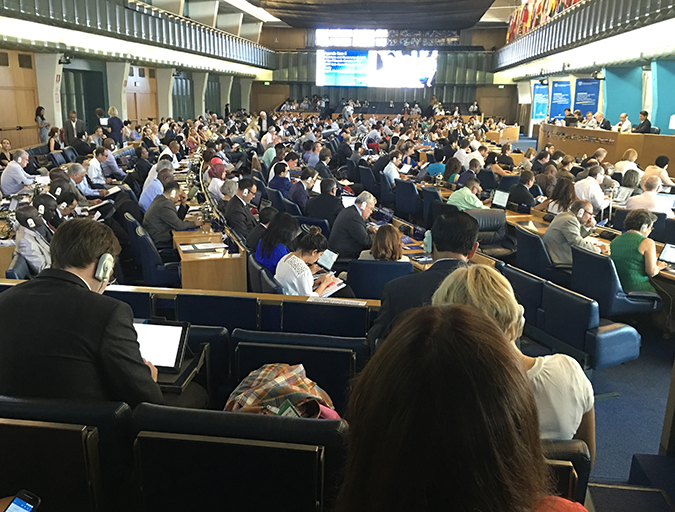Aquaculture can be a catalyst of change

While seafood sales may not be improving as much as they should in some countries (e.g., the United States, as mentioned in my column last issue), we clearly are seeing some giant steps in getting seafood on the agendas of many of the main world health, nutrition and food security meetings.
Such progress is never made unless discussions take place at the highest levels, so everyone connected with promoting seafood along the lines of human health, nutrition and food security needs to be applauded for the recent successes.
The battle is far from over, but clearly the tide is turning. When governments such as Mexico’s make commitments about increasing their countries’ seafood consumption, you start to see the benefits of all the hard work.
Global nutrition report
One of the most important documents of last year was the Global Nutrition Report 2014 (www.ifpri.org/publication/global-nutrition-report-2014) from the International Food Policy Research Institute. Its opening paragraph says: “Good nutrition is the bedrock of human well-being. Before birth and throughout infancy, good nutrition allows brain functioning to evolve without impairment and immune systems to develop more robustly.
For young children, good nutrition status averts death and equips the body to grow and develop to its full potential. Over the course of the human lifespan, it leads to more effective learning at school, better-nourished mothers who give birth to better-nourished children, and adults who are likelier to be productive and earn higher wages. In middle age, it gives people metabolisms that are better prepared to ward off the diseases associated with changes in diet and physical activity. Without good nutrition, people’s lives and livelihoods are built on quicksand.”
Obesity in United States, United Kingdom
This report has a special chapter on malnutrition in the United States and United Kingdom that should be ringing warning bells everywhere. That section of the report highlights that nutrition is a concern in all countries, not just low-income ones, with many high-income countries struggling with their own nutrition issues.
Obesity rates in the United States have more than doubled in adults and children since the 1970s – obesity is now a leading public health problem. Nearly 69 percent of U.S. adults and 32 percent of children and adolescents are overweight or obese. In most sex-age groups, the prevalence of obesity is lower among whites than among blacks and Mexican Americans. Many U.S. households suffer not only from the consequences of overweight and obesity, but also from food insecurity. In 2012, 14.5 percent of U.S. households were food insecure, as defined by the U.S. Department of Agriculture, at some time during the year.
According to the Feeding America website, in 2013, 49.1 million Americans lived in food-insecure households, including 33.3 million adults and 15.8 million children. The website explains that although related, food insecurity and poverty are not the same. Poverty is only one of many factors associated with food insecurity. Issues such as higher unemployment, lower household assets and certain demographic characteristics also lead to a lack of access to adequate, nutritious food. In the United Kingdom, 67 percent of men and 57 percent of women are considered overweight or obese. More than a quarter of children are also overweight or obese. In Western Europe, the United Kingdom lags behind only Iceland, where 74 percent of men and 61 percent of women are overweight or obese, and Malta, where the figures are 74 percent and 58 percent, respectively.
Multi-dimensional response
While some areas of obesity are trending down, it is too early, according to the experts, to understand the causes of this trend. Various examples of policy change will be important for countries to consider as they begin to grapple with these issues.
Some countries in Europe are proposing to address the obesity epidemic using a multi-sectorial government approach, focusing on improving school lunches, controlling advertising and marketing to children, taxing junk foods and over-processed foods, and promoting physical activity. Countries such as Mexico are taxing unhealthy foods and making a commitment to increase seafood consumption.
Accountability
Global Nutrition Report 2014 states: “The United States, United Kingdom and other high-income countries must be accountable for making progress toward the World Health Assembly target on preventing an increase in the number of children under 5 who are overweight. A whole-of-government approach, as proposed by some European countries, should be considered, taking into account the local context.”
This extensive report highlights that few countries are free from malnutrition, and many countries experience multiple burdens of malnutrition. Still, the emphasis is put on children under the age of 5, followed by the multiple dimensions of the nutrition status of women, then stunting, micronutrient deficiencies, and overweight and obesity.
The report also has highlighted the stable long-term relationship between improvements in the underlying drivers of stunting (such as food supply, clean water and sanitation coverage, and women’s secondary education enrollment) and decreases in stunting rates.
Nutrition champions
There is much to be gleaned from this document, but it is essentially aimed at what it calls “Nutrition Champions” and their current and potential allies, e.g., people and organizations who can form productive partnerships to accelerate improvements in nutrition outcomes. The major messages and recommendations for those seeking to accelerate malnutrition reduction through stronger policies, programs, research and advocacy obviously need to be tailored to audiences at the global, regional, national and subnational levels, according to context.
The Sustainable Fisheries and Aquaculture for Food Security and Nutrition report by the High Level Panel of Experts for the United Nation’s Committee on World Food Security brings the whole issue into perspective from an aquaculture standpoint. That report highlighted that capture fisheries and aquaculture provide 3 billion people with almost 20 percent of their average per-capita intake of animal protein, and a further 1.3 billion people with about 15 percent of their per-capita intake. The share exceeds 50 percent in some countries.
In Asia, where fisheries are extremely important, and fish farming has developed rapidly over the last 30 years, total dietary protein intake from fish is between 50 and 60 percent in Cambodia, Bangladesh, Indonesia and Sri Lanka. Fish provides a similarly significant proportion of protein in the diets of those who live in most small island states.
Rising demand
The continual growth in fish production – mostly from aquaculture since the 1990s – and improved production efficiency and distribution channels enabled the per-capita supply of fish for food to more than triple at world level since 1950, from 6 kg/year in 1950 to 19.2 kg/year in 2012. However, this global figure masks some important regional distinctions.
Asia accounts for almost two-thirds of global fish consumption and annual per-capita consumption of 21.4 kg in 2011 – a level similar to the 22.0 kg/person level in Europe. Africa, Latin America and countries in the Near East had the lowest yearly per-capita consumption: 10.4, 9.9 and 9.3 kg, respectively, in 2011.
World population growth – and more importantly urbanization and increasing living standards and income – are key drivers in the ongoing increases in seafood demand and fisheries development. Demand has been rising in both the developed and developing world at more than 2.5 percent yearly since 1950, and as wealth increases in highly populated countries such as China and India, demand is likely to continue its rise.
Perspectives
Of the key messages and recommendations presented in the Global Nutrition Report 2014, clearly front and center is that improvements in nutrition status contribute to many of the proposed Sustainable Development Goals (SDGs) that will form the primary global accountability mechanism for the next 15 years. Nutrition should be a prominent focus of the SDG framework, but currently only 1 of 169 SDG targets is explicitly related to nutrition.
Interestingly, the report states clearly that single-issue malnutrition is on the wane, and the days of separating under-nutrition from overweight and obesity are numbered, if not over. Countries are increasingly facing complex combinations of malnutrition and need to put more resources to resolving the issues.
As an example, it highlights that of 122 countries with data on stunting among children under 5, anemia in women of reproductive age and obesity in adults, fewer than 20 experience only one type of malnutrition. Importantly, the complexity should not be an excuse for inaction, but an urgent call for more effort to strategize, prioritize and sequence actions.
“Complexity must focus action, not stifle it” is a strong message to all nutrition actors regarding the need to be more aware of the nutritional, financial and political risks of addressing each burden in isolation. Given these multiple burdens, as well as the trend toward decentralization of nutrition programming by governments, it is more important than ever to produce subnational and other disaggregated analyses of nutrition outcomes.
Can our industry come together and be a catalyst for change in this important area?
(Editor’s Note: This article was originally published in the May/June 2015 print edition of the Global Aquaculture Advocate.)
Author
-

Roy D. Palmer, FAICD
GILLS
2312/80 Clarendon Street
Southbank VIC 3006 Australia
www.gillseafood.com[109,111,99,46,108,105,97,109,103,64,114,101,109,108,97,112,100,121,111,114]
Related Posts

Intelligence
Behold the nutritious oyster
Oysters provide important, natural filtration of water and are an important component of many healthy coastal ecosystems because their active filtering can help improve and maintain water quality. For many coastal communities, oysters are an important food resource and excellent sources of protein and amino acids, zinc, selenium, iron and B-vitamins.

Intelligence
Food is abundant, yet people are starving
While significant numbers of people are undernourished, an increasing number of people are overweight. The divide between recommendations and results is marked, so we must learn more about food production and change our behaviors.

Intelligence
COFI 32 presents an opportunity to promote seafood
Writing from Rome at the United Nations’ Food and Agriculture Organization’s COFI 32 conference, Advocate contributor Roy Palmer solicits input on how to promote the health benefits of seafood consumption worldwide.

Intelligence
Doctors: Place a greater value on seafood consumption
Many important organizations around the world fail to acknowledge the importance of seafood to human health and well-being. There is a disconnect between what we know regarding the benefits of seafood and what is being done to acknowledge these benefits and increase seafood consumption in nutrition.

